31 July - 10 November 1917
(They called it Passchendaele). My wound was slight
and I was hobbling back; and then a shell
burst slick upon the duckboards; so I fell
into the bottomless mud, and lost the light"
British commander-in-chief, Field-Marshall Haig, chooses Passchendaele as the target of his 1917 summer/autumn offensive because the ridge upon which the village stands dominates the flat, featureless Flanders plain. He believes that if the BEF can break out from the Ypres Salient and seize the ridge, his cavalry can then pour through the gap in the German line and sweep northward, driving the Germans from the Belgian coast and capturing the ports of Ostend and Zeebrugge, from where the German U-boat fleet has been sailing to wreak havoc on British merchant shipping.
Haig knows that the offensive will need to succeed quickly, as the rainy (autumn) season is approaching, and the chosen battlefield is unsuitable for operations in rainy conditions. The Ypres Salient occupies a lowlying plain, reclaimed from marshes over the years by an elaborate drainage system, and this reclaimed land is extremely vulnerable to shellfire that would destroy the drainage system and allow the land to flood. Haig is confident, however, that the breakthrough at Passchendaele will be so quick that his troops will have crossed the battlefield before rain or shellfire can have an effect. In the event, Haig is unfortunate that the 1917 Flanders rains turn out to be both early and continuous. They begin on the very day of his opening assault - 31 July 1917 - and produce thick, clinging mud, which cakes uniforms, clogs rifles, and makes impossible the intended supporting activity by tanks and cavalry. It eventually became so deep that, in many places, men, horses and pack mules drown in it.
The Germans are well aware of the strategic importance of Passchendaele Ridge, and therefore make it the most heavily-fortified part of their line. With the benefit of positions overlooking the British line, and of lax British security, the Germans know well in advance about the forthcoming offensive, and prepare devastating countermeasures. In the week leading up to the battle, they carry out a tactical retreat from their most advanced, low-lying positions, back to Passchendaele Ridge itself. This leaves a zone of marshland that the British will have to cross before they even reach the new German defensive line. The new German positions comprise three defensive lines, the third lying beyond the range of the British guns. Between these lines lie barbed wire, scattered concrete pillboxes and machine gun nests. The barbed wire funnels the attackers into killing zones where they can be swept by machine guns or annihilated by a crippling concentration of shells.
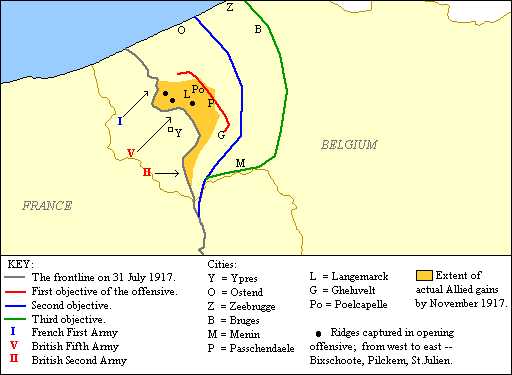
By mid-August, it is clear that Haig's plan to decisively break through at Passchendaele has failed, and the nature of the battle changes. Third Ypres takes the form of a series of offensives, slowly inching towards Passchendaele village. There is no more talk of breakthroughs, or reaching the Channel ports; instead capturing Passchendaele itself becomes the purpose of the battle, as does "attrition", ie the policy that although the advance costs the Allied side huge losses, it also inflicts grievous suffering upon the Germans, whose reserves of manpower are less able to make good the loss.
Through September and October, the British Fifth and Second Armies advance closer to Passchendale in a series of smaller-scale, but still hugely costly, offensives. By 9 October, the Australians are on the outskirts of Passchendaele, and in a series of attacks over the next three days they gain a temporary foothold in the village, but are driven out. The attack is resumed by the four divisions of the Canadian Corps, who finally on 10 November - in the face of a massive artillery bombardment and continual air attacks - capture what is left of the village. With the capture of the ruins of Passchendaele, the 1917 Flanders Offensive comes to a close.
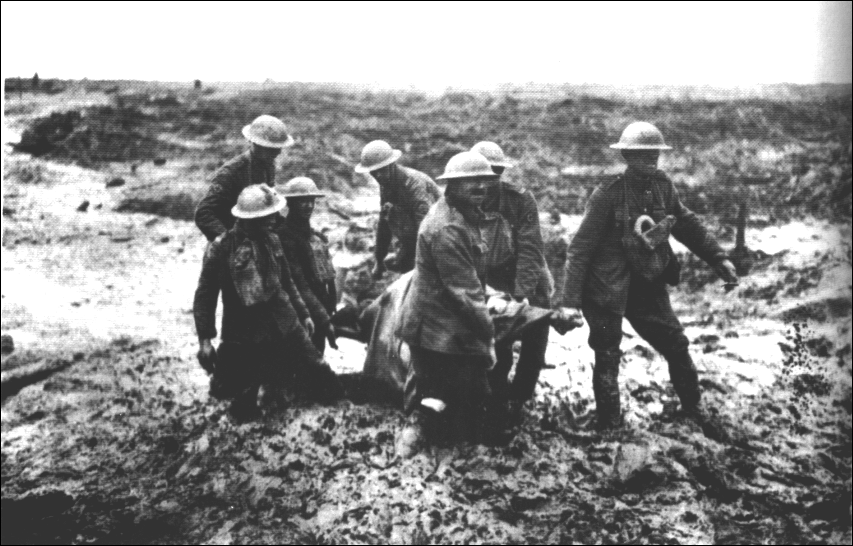
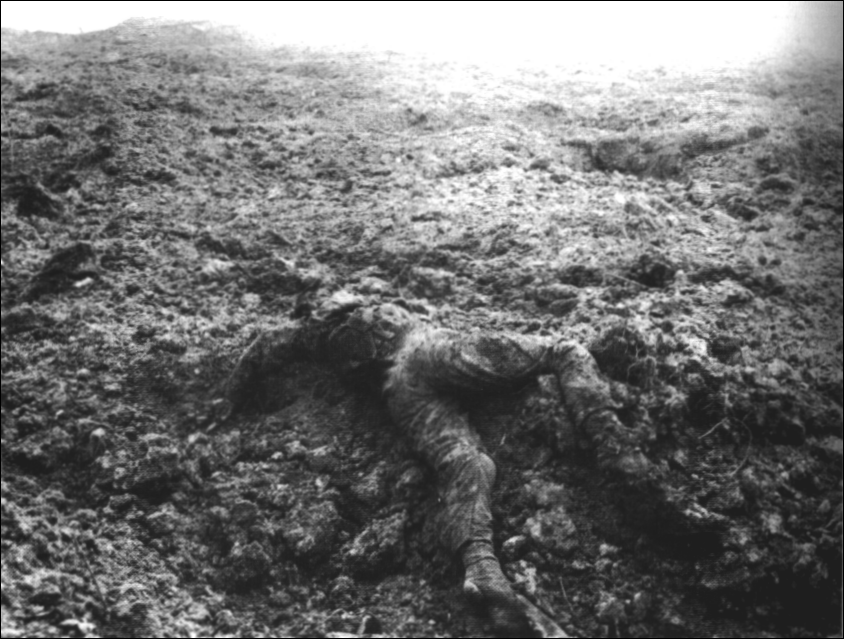
Pilckem Ridge, 1 August 1917.
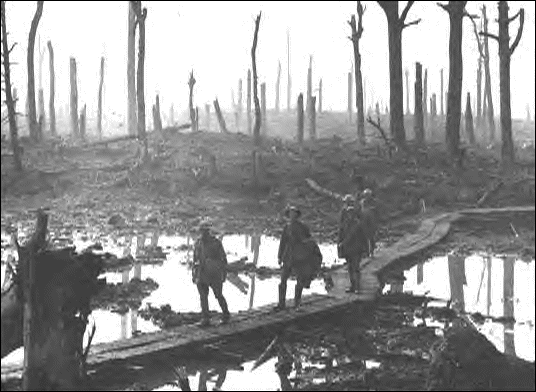
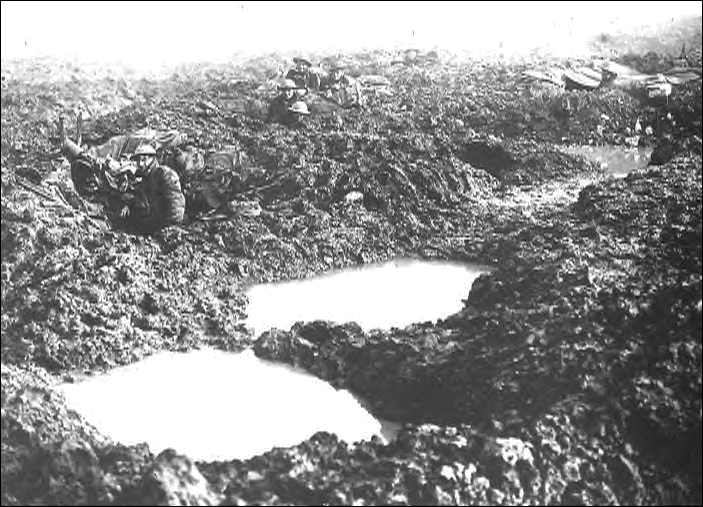
holding the new frontline at Passchendaele, 14 November 1917.
About 90,000 British or Australian bodies are recovered from the battlefield but never identified, and another 42,000 never recovered at all. Many of this 42,000 comprise the wounded who crawled into shell holes, thinking these would provide cover, but found themselves unable to climb above the mud, and so drowned there. A survivor recalled that "each shell hole with blood on its water usually meant another corpse entombed below", and another recalled seeing , "...a khaki-clad leg, three heads in a row, the rest of the bodies submerged, giving one the idea that they had used their last ounce of strength to keep their heads above the rising water. In another miniature pond, a hand still grabbing a rifle is all that is visible, while its next-door neighbour is occupied by a steel helmet and half a head, the staring eyes glaring icily at the green slime which floats on the surface almost at their level" (cited by Leon Wolff, "In Flanders Fields", page 347).
Among the bodies never found the Battle of Passchendaele is that of the Woods' third son, Joseph. Joe, a member of the Nelson Battalion of the Royal Naval Division, is killed in the final stages of the battle in the fighting around Poelcapelle, on 4 November 1917. He is commemorated with almost 35,000 other missing British troops on the Tyne Cot Memorial, near Zonnebeke, Flanders.
Four months after the end of Third Ypres, Poelcapelle, Passchendaele and all the territory won at such a high cost in the autumn of 1917, is recaptured by the Germans in their spring offensive of 1918.